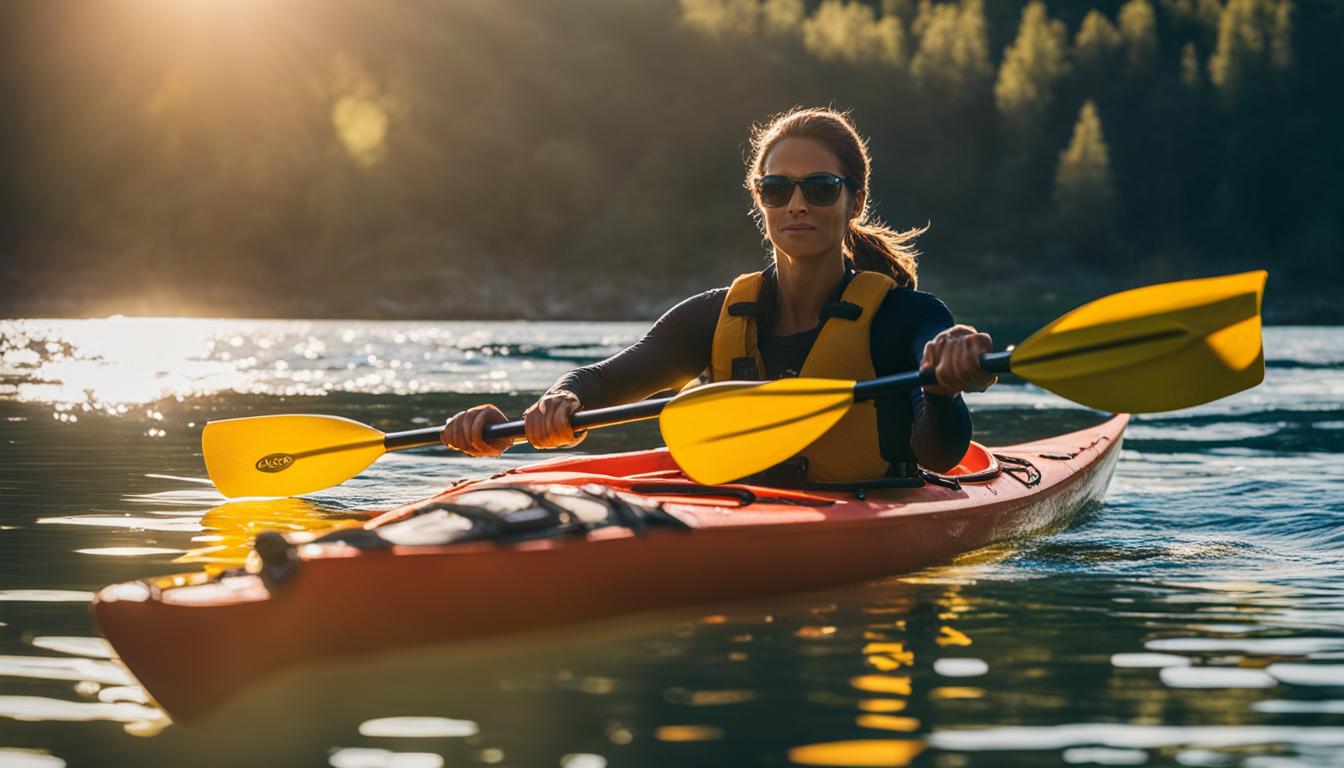Kayaking is not only a thrilling outdoor activity but also a great way to improve your fitness. It offers a full-body workout that engages muscles from your head to toe. By integrating kayaking into your workout routine, you can achieve overall fitness while enjoying nature’s beauty.
Are you tired of the same old workout routine? Want to try something fun and adventurous? Look no further than kayaking! Not only does it provide an exhilarating experience, but it also offers numerous health benefits.
When you think of kayaking, you may envision picturesque rivers, serene lakes, and breathtaking coastal views. But did you know that kayaking can also be a fantastic addition to your fitness regimen?
Integrating kayaking into your workout plan allows you to combine the joys of being in nature with improving your physical fitness. Whether you’re a beginner or an experienced paddler, kayaking provides an excellent opportunity to challenge yourself and achieve your fitness goals.
Key Takeaways:
- Kayaking is a thrilling outdoor activity that can improve your overall fitness.
- It offers a full-body workout, engaging muscles from head to toe.
- By integrating kayaking into your workout routine, you can enjoy nature’s beauty while achieving fitness goals.
- Kayaking provides a unique and fun alternative to traditional workout routines.
- It is an excellent way to challenge yourself and achieve physical fitness goals.
Kayaking: A Full-Body Workout

Kayaking is not just a fun water sport; it also offers a full-body workout that engages multiple muscle groups. While it may seem like primarily an upper-body exercise, kayaking actually works your arms, shoulders, back, core, and legs. The rotational movements involved in paddling engage your abdominal and lower back muscles, helping to strengthen and tone them. Additionally, your legs play a crucial role in providing stability and controlling the kayak’s direction.
One of the key benefits of kayaking as a workout is its calorie-burning potential. Depending on factors such as your weight and intensity of paddling, you can burn an average of 400-500 calories per hour while kayaking. This makes it an excellent choice for those looking to shed some pounds or maintain a healthy weight. Furthermore, the constant resistance provided by the water helps to build lean muscle mass and improve overall muscle tone.
If you’re looking to take your kayaking workout to the next level, consider incorporating kayak-based strength training exercises. These exercises utilize the resistance of the water and the instability of the kayak to challenge your muscles even further. Examples of kayak-based strength training exercises include kayak planks, kayak push-ups, and kayak squats. These exercises target specific muscle groups and enhance both strength and stability.
Kayaking for Cardiovascular Fitness
Kayaking is not just a fun and thrilling outdoor activity; it is also an excellent way to improve your cardiovascular fitness. Regular kayaking sessions can significantly enhance your heart’s endurance and capacity to deliver oxygen to your muscles, resulting in improved overall fitness. Whether you’re a beginner or an experienced paddler, kayaking offers a fun and effective way to achieve recommended levels of cardiovascular activity.
Endurance building through kayaking is a gradual process that requires consistency. Start with shorter paddles and gradually increase the duration and intensity of your kayaking sessions as your fitness improves. Aim for at least 20-30 minutes of continuous paddling at a moderate intensity, such as a steady pace that allows you to hold a conversation without gasping for breath. As your cardiovascular fitness improves, you can challenge yourself with longer and more intense kayaking adventures.
Tracking your fitness progress in kayaking can help you stay motivated and monitor your improvement over time. You can use a fitness tracker or smartphone app to record the duration, distance, and average heart rate of each kayaking session. Set goals for yourself, such as increasing the distance or reducing your average heart rate, and track your progress to see how far you’ve come. Celebrate your achievements along the way and use them as fuel to keep pushing yourself further.

Sample Table: Tracking Fitness Progress in Kayaking
| Date | Duration (minutes) | Distance (miles) | Average Heart Rate (bpm) |
|---|---|---|---|
| June 1, 2022 | 30 | 3 | 135 |
| June 8, 2022 | 45 | 4 | 128 |
| June 15, 2022 | 60 | 5 | 120 |
| June 22, 2022 | 75 | 6 | 114 |
As you can see from the sample table above, tracking your fitness progress in kayaking can provide valuable insights into your performance. You can observe trends in your duration, distance, and average heart rate, allowing you to identify areas for improvement and set new goals. Remember to listen to your body, take rest days when needed, and consult with a healthcare professional before starting any new exercise regimen, especially if you have pre-existing health conditions.
Kayaking for Mental Health Benefits
When it comes to kayaking, the benefits extend beyond physical fitness. Immersing yourself in nature while paddling through serene waters can be a powerful stress reliever. Research has shown that spending time in nature can reduce anxiety and improve mood. The tranquility of the water and the breathtaking scenery provide a calming environment that allows you to escape the pressures of daily life.
Kayaking also offers an opportunity to boost self-confidence and enhance mental resilience. As you navigate the waters and overcome challenges, you develop a sense of accomplishment and gain confidence in your abilities. Each successful stroke and maneuver reinforces your belief in yourself, fostering a positive mindset that can extend into other areas of your life. The resilience you build on the water can help you face and overcome obstacles in your personal and professional endeavors.
Disconnect from the digital world and reconnect with yourself and nature. Let the rhythmic motions of kayaking guide you to a place of inner peace and serenity.
Additionally, kayaking provides a meditative experience that promotes mindfulness. The repetitive and rhythmic nature of paddling can induce a state of mindfulness, allowing you to fully focus on the present moment. As your mind becomes attuned to the gentle rhythm of your strokes, you let go of worries and distractions, cultivating a sense of tranquility and clarity. Kayaking becomes more than just a physical activity; it becomes a spiritual journey that connects you to the natural world and to yourself.
Benefits of Kayaking for Mental Health:
- Stress relief through immersion in nature
- Boosts self-confidence and mental resilience
- Promotes mindfulness through repetitive and rhythmic movements
- Fosters a sense of peace, tranquility, and connection with the natural world
So, whether you’re seeking a break from the stresses of everyday life or looking to enhance your mental well-being, kayaking can be a transformative experience. Disconnect from the digital world and reconnect with yourself and nature. Let the rhythmic motions of kayaking guide you to a place of inner peace and serenity. And remember, the best therapist has fur and four legs – bring your furry friend along for an even more enjoyable and therapeutic kayaking adventure.
| Activity | Nature as a Stress Reliever | Boosts Self-Confidence | Promotes Mindfulness | Connection with Nature |
|---|---|---|---|---|
| Kayaking | ✓ | ✓ | ✓ | ✓ |
| Hiking | ✓ | ✓ | ✓ | ✓ |
| Yoga | ✓ | ✓ | ✓ | ✓ |
| Cycling | ✓ | ✓ | ✓ | ✓ |
Kayaking for Mindfulness and Connection
Kayaking is not just a physical activity, it can also be a powerful mindfulness practice. When you paddle through the serene waters, you have the opportunity to fully engage with your surroundings and be present in the moment. The rhythmic strokes of your paddle and the sensory experience of being immersed in nature facilitate a deep sense of peace and connection. As you navigate the water, you can let go of distractions and focus on the present moment, allowing your mind to find calm and clarity.
In addition to mindfulness, kayaking can also be a tool for setting fitness goals. With each paddle stroke, you can challenge yourself to reach new distances or improve your speed. Setting goals gives you something to strive for and helps keep you motivated and focused. Whether it’s aiming to paddle a certain distance, explore new waterways, or master advanced techniques, kayaking provides endless possibilities for pushing yourself and achieving personal milestones.
To enhance your mindfulness practice and track your progress, you can use a fitness tracker or journal to record your kayaking activities. Keep a log of the routes you paddle, the time spent on the water, and any challenges or breakthroughs you experience. This will not only help you stay organized but also allow you to see the progress you’ve made over time. Celebrate your achievements and use them as fuel to continue your kayaking journey and reach new levels of mindfulness and fitness.
| Benefits of Kayaking for Mindfulness and Connection |
|---|
| Enhances mindfulness skills |
| Deepens connection with nature |
| Provides a sense of peace and calm |
| Offers opportunities for personal growth |
Embark on your kayaking adventure with the intention of being present and fully engaged. Let the rhythmic flow of the water and the beauty of nature guide you into a state of mindfulness. Set goals that challenge you and keep a record of your progress. As you connect with the water and immerse yourself in the present moment, you’ll discover the transformative power of kayaking for both your body and mind.
Conclusion
Kayaking offers a unique combination of fitness, fun, and connection with nature. It provides a full-body workout, improves cardiovascular fitness, and promotes mental well-being. Whether you’re a beginner or an experienced kayaker, there are various workout challenges and opportunities for kayak-based strength training.
Challenge yourself with different kayaking workout routines to enhance your fitness levels. You can incorporate interval training by alternating between bursts of intense paddling and periods of rest. This will help boost your cardiovascular endurance and burn more calories. Additionally, try out kayak-based strength training exercises such as kettlebell swings while sitting in the kayak to target your core and upper body muscles.
Remember, kayaking is not just about the physical benefits. It allows you to escape the hustle and bustle of daily life and immerse yourself in the tranquil beauty of nature. So, swap the gym for the great outdoors and let the healing power of kayaking work its magic on you. Happy paddling!
FAQ
Is kayaking only an upper-body workout?
No, kayaking engages muscles in your arms, shoulders, back, core, and legs.
Does kayaking help improve cardiovascular fitness?
Yes, kayaking is an aerobic exercise that increases your heart’s endurance and capacity.
Can kayaking reduce stress and improve mental health?
Absolutely, spending time in nature and the meditative experience of kayaking can lower stress levels and improve mood.
Is kayaking a good activity for mindfulness?
Yes, kayaking allows you to be present in the moment and engage with your surroundings, enhancing mindfulness skills.
Can I track my fitness progress with kayaking?
Yes, kayaking can be used to set fitness goals and monitor progress, especially in terms of endurance and cardiovascular activity.





